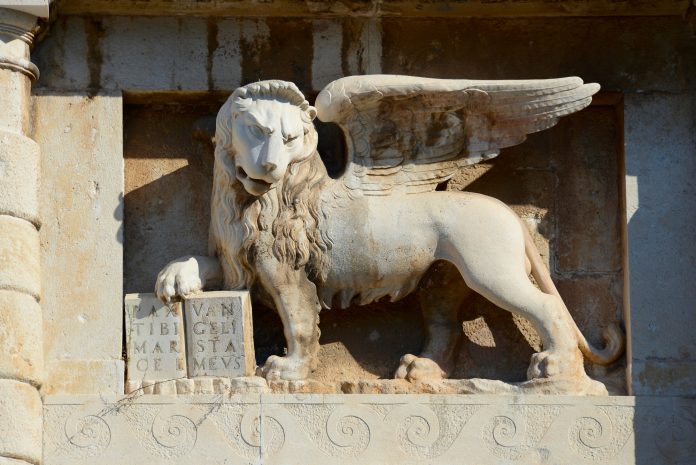Walk through the sunlit alleys of any Dalmatian town — from Zadar to Hvar, Trogir to Kotor — and look up. Above fortress gates, on the facades of public buildings, or even crumbling on abandoned village wells, you’ll find him: a majestic winged lion, frozen mid-step, sometimes holding a book, sometimes a sword. He is the Lion of Saint Mark, and his story is older, deeper, and more layered than most passing travelers could ever guess.
A Gospel’s Roar
The origins of the Lion lie not in politics, but in scripture. Early Christians assigned symbols to each of the four Gospel writers, based on their narrative style and spiritual themes. Saint Mark was given the lion — winged, bold, and unrelenting. His Gospel begins with a voice crying in the wilderness, echoing Isaiah: “Prepare the way of the Lord.” That cry was seen as the lion’s roar: powerful, urgent, awakening. The wings were later added to represent divine inspiration.
But Mark wasn’t just a writer — he became a wanderer. After accompanying both Peter and Paul, tradition says he founded the Church of Alexandria. Centuries later, in 828 AD, Venetian merchants stole his relics from Egypt, hiding them beneath pork to avoid Muslim inspection, and brought them to the rising city of Venice. There, Mark replaced Saint Theodore as the city’s new patron. And the lion, his symbol, became the emblem of Venetian identity.
This transformation of Mark from a Biblical figure to a civic emblem wasn’t instant. It took generations for the people of Venice to embrace the lion as their protector. Over time, as the city grew into a naval and mercantile superpower, the lion took on new layers of meaning: courage, protection, divine favor, and cultural pride.
The Peace of Mark
Accompanying the lion is often a Latin phrase, carved into stone beneath or beside him:
PAX TIBI MARCE EVANGELISTA MEUS
“Peace to you, Mark, my Evangelist.”
According to legend, this was the message delivered to Mark by an angel as he arrived in a storm on the Venetian lagoon. It became more than a greeting — it was a blessing, a prophecy, and later, a declaration of dominion.
Lions with open books bearing this inscription were often placed during peacetime. But when Venice went to war, the book closed — and a sword sometimes replaced it. The lion shifted from saintly protector to roaring conqueror.
This duality — peace and power — was not accidental. Venice prided itself on being both a cultural beacon and a strategic force. The lion, with his scriptural blessing and silent authority, embodied that paradox perfectly.
From Lagoon to Limestone: Venice in Dalmatia
During the height of its maritime power, the Venetian Republic extended its reach across the Adriatic. Dalmatian cities and islands fell under Venetian control from the 15th to the 18th century. And wherever the Serenissima went, the lion followed.
Dalmatia, with its stone towns, strategic ports, and deep-rooted Catholic identity, was both a prize and a mirror for Venice. Here, the lion was carved into gatehouses, wells, columns, clock towers, and coastal fortresses.
In Zadar, he perches over the Land Gate, a grand welcome to what was once a key Venetian stronghold. In Trogir, he watches from the Kamerlengo Fortress. In Hvar, he sits silently atop the Arsenal. And even in remote villages on Brač and Vis, smaller, humbler lions remind passersby of centuries of Venetian order.
Sometimes fierce and sharp-toothed.
Sometimes weathered and weary.
Sometimes barely visible, as if fading with time.
These lions were not just decorative — they were claims. They asserted ownership, legacy, and continuity. Venice was here. Venice ruled. And Saint Mark, its heavenly advocate, watched over it all.
Lions Across the Sea
Interestingly, the Lion of Saint Mark is not exclusive to the Adriatic. From Crete to Cyprus, from Dalmatia to Corfu, the Venetian lion roamed. But in Dalmatia, his presence feels especially resonant.
Perhaps it’s because this coast was never truly subdued — always distinct, always proud. Dalmatian identity adapted Venetian rule without losing itself. The lion became part of the landscape, but the soul of the land remained deeply local.
In some cases, locals even resisted the lion. During times of rebellion, lions were defaced or torn down. In the 20th century, under different regimes, some were removed. But others survived, often because they had become part of the town’s own story.
Today, they’re sometimes restored, sometimes ignored. But they are never meaningless.
Symbols That Shift
To some, the Lion of Saint Mark still represents colonial rule — a symbol of centuries-long Venetian dominance. To others, it’s just a familiar fixture, part of the aesthetic of old towns.
But to those who walk these streets with eyes open to story, the lion is more than a relic.
He is a reminder that history is layered — that meaning changes over time.
A symbol of an empire became, in time, a part of the stone.
A mark of dominance became a witness of resilience.
The lion, like the cities he guards, has changed. He no longer roars. But he still watches.
The Echo of the Roar
I often find myself standing below one of these lions, wondering: how many people have passed beneath him, unaware? How many glances, prayers, weddings, farewells, revolts, invasions, and returns has he witnessed?
He has seen the rise and fall of empires, the comings and goings of rulers, the steady heartbeat of human life. Children once played in his shadow. Soldiers once marched beneath his gaze. Priests blessed him. Rebels cursed him.
And now tourists photograph him.
But that’s the beauty of carved stone — it doesn’t care who looks, only that someone does. It’s there to endure.
Legacy in Limestone
In the end, the Lion of Saint Mark isn’t just about Venice, or power, or even religion. He’s about memory. About how we carve our stories into stone, hoping they’ll last longer than we do.
He’s about the blending of myth and history, the way symbols transcend their original purpose.
So next time you walk through a Dalmatian town and look up, pause.
Look the lion in the eyes.
He has something to tell you.
And if you listen carefully beneath the sound of church bells and sea winds, you might still hear the echo of that Gospel’s cry:
Prepare the way.

